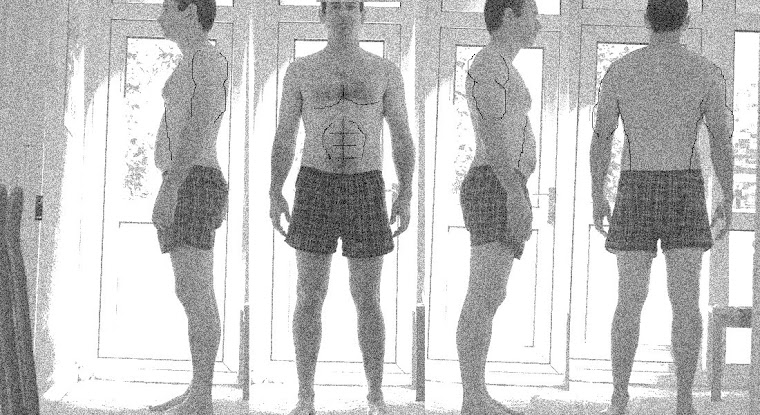Here is a good list of bodyweight exercises for all different levels, taken from Wikipedia.
| Name | Muscle groups | Description |
|---|---|---|
| Dip | Arms (triceps), chest,back | Hanging from a dip bar or other implement with the arms straight and the shoulders positioned above the hands, the body is lowered until the arms are bent at a 90 degrees angle. |
| Bridge | Back (deep spinal muscles), flexibility, arms (triceps), upper legs | The person will begin in a sit up position with the hands positioned by the ears, palms down, fingers facing the legs. The person pushes up with the arms and the back muscles until the body resembles a lowercase 'n'. The spine must be convex and the limbs straight. The exercise can be made harder by entering the bridge from a standing position (bending the back backwards in a controlled manner into the bridge.) |
| Press-up / Push-up | Chest, arms (triceps),shoulders | In a prone position, the body is raised and lowered using the arms while the back remains straight and the toes remain on the ground. The exercise can be made more difficult by placing the legs at an incline. Thus, the upper body must support more weight. The exercise can be made even more difficult by performing it with a single arm. Notable variations include the Hindu pushup (dand), the divebomber pushup, and the diamond pushup. |
| Handstand push-up | Shoulders, triceps, trapezius | The body is positioned in a handstand, is lowered and pushed up. |
| Planche | Full Body | Holding one's body in the air, in a line parallel to and facing the floor through balancing one's entire bodyweight on both hands with straight arms. |
| Plank | Core (abdominals, back and shoulders) | Lying on the stomach and lifting the body by keeping the toes and forearms on the ground. |
| Pull up | Back with emphasis on latissimus dorsi, forearm,biceps, rear deltoid, trapezius, erector spinae, abdominals. | Hanging from a bar with arms extended and palms facing away from the exerciser, the body is pulled up until the elbows are bent and the head is higher than the hands. |
| Chin-up | Back, arms (biceps) | Like the pull-up, but with the palms facing towards the exerciser. The closer the hands, the more the emphasis on the biceps. |
| Crunch | Abdomen | Lying face up on the floor, the shoulders are curled towards the pelvis while the lower back remains flat against the floor. Focus is put on contracting the abdominal muscles. |
| Sit-up | Abdomen, hip flexors | It begins with lying with the back on the floor, typically with the knees bent in an attempt to reduce stress on the back muscles and spine, and then elevating both the upper and lower vertebrae from the floor until everything superior to the buttocks is not touching the ground. |
| Russian twist | Abdomen|Obliques | Sitting on the floor with knees bent as in a sit-up, with the back kept straight and at a 45 degree angle to the floor, the straightened arms are held outstretched with the hands locked together. The arms are moved from one side of the body to another in a twisting motion. |
| Squat | Legs | Standing up, the legs are bent at the knees and hips, lowering the torso between the legs. The torso leans forward to maintain balance. (Usually called abodyweight squat to distinguish it from the use of weights.) The single leg squat, or "pistol squat", can be used to make the exercise significantly harder as it requires one to have a great deal of balance, flexibility, and strength. |
| Hyperextension | Lower back, erector spinae | Lying face down on the floor, the torso and arms are lifted up at the same time. |
| L seat | Abdomen|Obliques, arms (triceps) | The person will sit in an L position with the legs straight and parallel to the ground and the upper body perpendicular to the ground. The hands are placed beside the glutes. The hands then push the entire body upwards off the ground. The legs must remain off the ground and parallel to the ground. The exercise taxes the muscles through isometric tension. |
| Human flag | Abdomen|Obliques, full body | The person will grab a vertical object such as a pole or tree trunk, with both hands palms pronated. The practitioner will lift the entire body using the abdominal muscles into a position parallel to the ground. |
| Calf raises | Calf muscle | Standing calf raises are executed with one or both feet on a raised surface with the heel lower than the toes. The exercise is performed by raising the heel as far as possible. The exercise can be made harder by performing the exercise on one leg. |
| Leg raises | Abdomen, hip flexors | Lie on the floor on your back. Keep the lower back in contact with the floor and place hands to sides or under lower back for support. Lift legs upward as far as possible. Lower down to starting position slowly and with control. Make sure the back stays flat on floor and that the abdominal muscles are tight. The exercise can be made significantly harder by performing the exercises from a hanging apparatus, such as a pull up bar, and lifting the legs upwards until parallel with the ground. The exercise can further be increased in difficulty by lifting the legs to the utmost vertical position (to the head). |

No comments:
Post a Comment